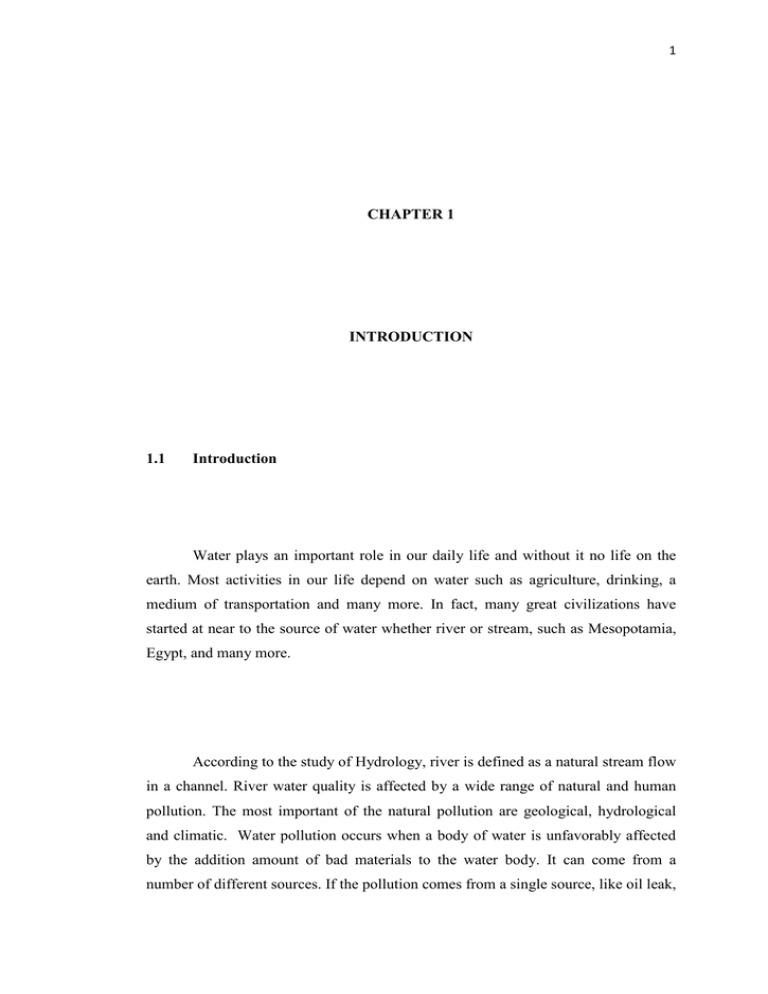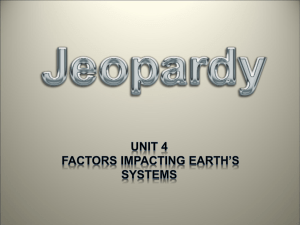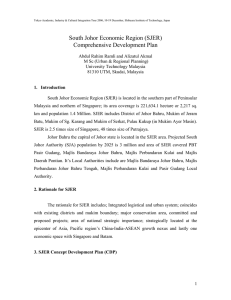CHAPTER 1 INTRODUCTION 1.1
advertisement

1 CHAPTER 1 INTRODUCTION 1.1 Introduction Water plays an important role in our daily life and without it no life on the earth. Most activities in our life depend on water such as agriculture, drinking, a medium of transportation and many more. In fact, many great civilizations have started at near to the source of water whether river or stream, such as Mesopotamia, Egypt, and many more. According to the study of Hydrology, river is defined as a natural stream flow in a channel. River water quality is affected by a wide range of natural and human pollution. The most important of the natural pollution are geological, hydrological and climatic. Water pollution occurs when a body of water is unfavorably affected by the addition amount of bad materials to the water body. It can come from a number of different sources. If the pollution comes from a single source, like oil leak, 2 we called it, point-source pollution. While, the pollution that comes from many unknown sources called, non-point source pollution. Approximately, all the pollution types affect the immediate area surround for that source. Sometimes the pollution may affect the environment for miles away from the source. The effects of water pollution are not just hurtful for people, but it has effects on habitat such as animals, fish, and birds. It can destroy the aquatic life and reduces its productive ability. It is also hazardous to human health, and overall water supply system. In Malaysia, there are 1800 rivers comprising 150 systems that run up to 38000 km. As in many part of the world, water from rivers in Malaysia is used extensively for domestic needs, agriculture, drinking, cooking, washing, and many other purposes. One of those rivers is Johor River. It is very important fresh water supply to the treatment plant located at Kota Tinggi which distributed treated water to eater local need. The water quality of Johor River has been deteriorated with increasing level of various pollutants. This contaminant eventually flow into Johor River from the area neighbor it. Computer simulation and numerical model is one of the best ways for hydrodynamic study and controlling the water quality. It is powerful and essential tool to monitoring plan in making decision related to the parameters of the water quality. We can compile and analyze the hydrodynamic data and the water quality parameters data for a particular length of river to evaluate river water quality. HEC-RAS is an integrated system composed of separate hydraulic analysis components, data storage and management capabilities, graphics, and reporting facilities. The system ultimately contains three one-dimensional hydraulic analysis 3 components for (1) steady flow water surface profile computations, (2) unsteady flow simulation, and (3) moveable boundary sediment transport computations. All three components use a common geometric data representation and common geometric and hydraulic computation routines. In addition, the system contains several hydraulic design features that can compute the basic water surface profiles. Qual2e is a one-dimensional mathematical model. It is available as free software to simulate river water quality. It is a multi-purpose model for determining the quality of stream flow by allowing the simulation of fifteen parameters associated to water quality in any reach of river chosen by researcher. The model is applicable to well mixed streams and considers the transport mechanisms – dispersion and advection – significant only along the main direction of flow (longitudinal direction). When the discharge decrease as well as the depth of water will reduce, the vegetation buffer strip area will increase within the river. So, this area can play as filter to intercept the sediment transport capacity. Riparian buffer is the area of permanent vegetation (trees, shrubs and grass) neighbor surface water bodies, and are to improve water quality by trapping or removing various non-point source pollutants from over land and shallow subsurface flowing in the same time [14]. It is important to use vegetation buffers in reducing the contaminant to the river especially before or during the high discharges. 4 1.2 Statement of the Problem The development over the entire world leads to more concentration on water quality which is consider as a sensitive matter and has affects on humans and environment. The contamination loadings in Johor River come from many sources as a non-point source contamination, when the rain falls on catchment area surround Johor River. The contaminant substances are carried by runoff, and before the contaminants enter the water body, they pass through the buffer zones to pour in watershed or directly to the river. This would create many problems for the water quality status such as decrease in dissolved oxygen, harmful algal blooms, and reduced light penetration. Moreover, the sediment transport capacity also consider as a serious problem which is affect on the flow depth and bed river condition. The study on hydrological characteristics of river is so important for future development especially in water resources engineering in term of water resource management. The aim of this study is to determine and analyze the concentration of some parameters which are considered as important parameters to cover river water quality. These parameters are Dissolved Oxygen (DO), Biochemical Oxygen Demand (BOD), Total Suspended Solid (TSS), and PH, and also sediment transport capacity for several cross sections. Because the raw water of the Johor River is used to supply the domestic requirement, therefore, all these parameters are compared to the Interim National Water Quality Standard (INWQS) provided by Department of Environment (DOE). 5 1.3 Objective of Study 1. To estimate a hydrological model for 5000 m of Johor River using HECRAS. 2. To predict the fluctuation water level for and sediment transport capacity for different discharge using HEC-RAS. 3. To analyze and simulate water quality for Johor River using QUAL2E program. 4. To estimate the typical concentration of suspended solid and trap efficiency of the vegetation buffer strip along the Johor River. 1.4 Scope of Study The scope of this study is as follows: 1. Buffer zones identification. 2. Water quality sampling and the analysis in the lab after we bring the samples from the site. 3. IN-SITU testing. 4. Sediment transport capacity calculation. 5. Getting Samples from the river for grain size test.




